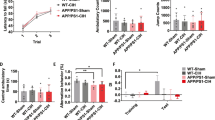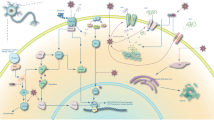Abstract
Purpose
Obstructive sleep apnea (OSA) is a sleep disorder that may lead to cognitive impairment. The primary pathophysiological feature of OSA is chronic intermittent hypoxia (CIH), but the underlying mechanisms of CIH are not known. There have been few studies on the role of ferroptosis, a novel form of programmed cell death, during CIH-induced cognitive impairment. Therefore, this paper examined ferroptosis’ effect on CIH-mediated cognitive impairment.
Methods
The study randomized twenty-four Sprague–Dawley (SD) male rats to control or CIH group. CIH rats were subjected to intermittent hypoxia for 4 weeks. Rat learning and memory were analyzed by the Morris water maze (MWM) test. Alterations of hippocampal neuronal ultrastructure were observed by transmission electron microscopy (TEM). Malondialdehyde (MDA) and ferrous iron (Fe2+) levels and superoxide dismutase (SOD) and reduced glutathione (GSH) contents were determined. Ferroptosis-associated protein levels were examined by Western blotting.
Results
The MWM test indicated that rats in the CIH group exhibited neurocognitive impairment. TEM showed that CIH induced mitochondrial damage. Significant increases in Fe2+ and MDA levels were observed in the CIH group, and GSH and SOD levels were decreased. Expression of Acyl-CoA synthetase long-chain family member 4 (ACSL4) increased, and glutathione peroxidase 4 (GPX4) protein levels were decreased, suggesting that ferroptosis was induced in CIH model rats. The NF-E2-related factor 2 (Nrf2) protein level in the CIH group was decreased.
Conclusion
Ferroptosis had an essential effect on CIH-mediated cognitive impairment, and it may occur via Nrf2 dysregulation. These findings lay a solid foundation for the subsequent study of OSA-associated cognitive impairment offering potential evidence for the development of therapeutic strategies.





Similar content being viewed by others
Data availability
Data utilized and/or analyzed in this work can be obtained from corresponding author upon request.
References
Benjafield AV, Ayas NT, Eastwood PR, Heinzer R, Ip MSM, Morrell MJ et al (2019) Estimation of the global prevalence and burden of obstructive sleep apnoea: a literature-based analysis. Lancet Respir Med 7(8):687–698. https://doi.org/10.1016/S2213-2600(19)30198-5
Zhu X, Zhao Y (2018) Sleep-disordered breathing and the risk of cognitive decline: a meta-analysis of 19,940 participants. Sleep Breath 22(1):165–173. https://doi.org/10.1007/s11325-017-1562-x
Kotterba S, Rasche K, Widdig W, Duscha C, Blombach S, Schultze-Werninghaus G et al (1998) Neuropsychological investigations and event-related potentials in obstructive sleep apnea syndrome before and during CPAP-therapy. J Neurol Sci 159(1):45–50. https://doi.org/10.1016/s0022-510x(98)00131-2
Dixon SJ, Lemberg KM, Lamprecht MR, Skouta R, Zaitsev EM, Gleason CE et al (2012) Ferroptosis: an iron-dependent form of nonapoptotic cell death. Cell 149(5):1060–1072. https://doi.org/10.1016/j.cell.2012.03.042
Xie Y, Hou W, Song X, Yu Y, Huang J, Sun X et al (2016) Ferroptosis: process and function. Cell Death Differ 23(3):369–379. https://doi.org/10.1038/cdd.2015.158
Ding H, Yan CZ, Shi H, Zhao YS, Chang SY, Yu P et al (2011) Hepcidin is involved in iron regulation in the ischemic brain. PLoS One 6(9):e25324. https://doi.org/10.1371/journal.pone.0025324
Friedmann Angeli JP, Schneider M, Proneth B, Tyurina YY, Tyurin VA, Hammond VJ et al (2014) Inactivation of the ferroptosis regulator Gpx4 triggers acute renal failure in mice. Nat Cell Biol 16(12):1180–1191. https://doi.org/10.1038/ncb3064
Belaidi AA, Bush AI (2016) Iron neurochemistry in Alzheimer’s disease and Parkinson’s disease: targets for therapeutics. J Neurochem 139:179–197. https://doi.org/10.1111/jnc.13425
DeMartino T, Ghoul RE, Wang L, Bena J, Hazen SL, Tracy R et al (2016) Oxidative stress and inflammation differentially elevated in objective versus habitual subjective reduced sleep duration in obstructive sleep apnea. Sleep 39(7):1361–1369. https://doi.org/10.5665/sleep.5964
Chi SI, Wang CK, Chen JJ, Chau LY, Lin TN (2000) Differential regulation of H- and L-ferritin messenger RNA subunits, ferritin protein and iron following focal cerebral ischemia–reperfusion. Neuroscience 100(3):475–484. https://doi.org/10.1016/s0306-4522(00)00317-1
Farré R, Rotger M, Montserrat JM, Calero G, Navajas D (2003) Collapsible upper airway segment to study the obstructive sleep apnea/hypopnea syndrome in rats. Respir Physiol Neurobiol 136(2–3):199–209. https://doi.org/10.1016/s1569-9048(03)00082-x
Vorhees CV, Williams MT (2006) Morris water maze: procedures for assessing spatial and related forms of learning and memory. Nat Ptherotoc 1(2):848–858. https://doi.org/10.1038/nprot.2006.116
Wang G, Goebel JR, Li C, Hallman HG, Gilford TM, Li W (2020) Therapeutic effects of CPAP on cognitive impairments associated with OSA. J Neurol 267(10):2823–2828. https://doi.org/10.1007/s00415-019-09381-2
Caporale M, Palmeri R, Corallo F, Muscara N, Romeo L, Bramanti A et al (2021) Cognitive impairment in obstructive sleep apnea syndrome: a descriptive review. Sleep Breath 25(1):29–40. https://doi.org/10.1007/s11325-020-02084-3
Wang Y, Cheng C, Moelter S, Fuentecilla JL, Kincheloe K, Lozano AJ et al (2020) One year of continuous positive airway pressure adherence improves cognition in older adults with mild apnea and mild cognitive impairment. Nurs Res 69(2):157–164. https://doi.org/10.1097/NNR.0000000000000420
Canessa N, Castronovo V, Cappa SF, Aloia MS, Marelli S, Falini A et al (2011) Obstructive sleep apnea: brain structural changes and neurocognitive function before and after treatment. Am J Respir Crit Care Med 183(10):1419–1426. https://doi.org/10.1164/rccm.201005-0693OC
Deguil J, Ravasi L, Lanteaume L, Lamberty Y, Bordet R (2016) Translational challenge models in support of efficacy studies: effect of cerebral hypoxia on cognitive performances in rodents. CNS Neurol Disord Drug Targets 15(7):765–776. https://doi.org/10.2174/1871527315666160518124926
Lam CS, Tipoe GL, So KF, Fung ML (2015) Neuroprotective mechanism of Lycium barbarum polysaccharides against hippocampal-dependent spatial memory deficits in a rat model of obstructive sleep apnea. PLoS One 10(2):e0117990. https://doi.org/10.1371/journal.pone.0117990
He Y, Liu Z, Huang Y, Li B (2021) Role of the p38MAPK signaling pathway in hippocampal neuron autophagy in rats with chronic intermittent hypoxia. J Neurophysiol 126(4):1112–1121. https://doi.org/10.1152/jn.00240.2021
Li W, Yang S, Yu FY, Zhao Y, Sun ZM, An JR et al (2018) Hydrogen ameliorates chronic intermittent hypoxia-induced neurocognitive impairment via inhibiting oxidative stress. Brain Res Bull 143:225–233. https://doi.org/10.1016/j.brainresbull.2018.09.012
Macey PM, Henderson LA, Macey KE, Alger JR, Frysinger RC, Woo MA et al (2002) Brain morphology associated with obstructive sleep apnea. Am J Respir Crit Care Med 166(10):1382–1387. https://doi.org/10.1164/rccm.200201-050OC
Vatansever E, Surmen-Gur E, Ursavas A, Karadag M (2011) Obstructive sleep apnea causes oxidative damage to plasma lipids and proteins and decreases adiponectin levels. Sleep Breath 15(3):275–282. https://doi.org/10.1007/s11325-010-0378-8
Chen Q, Chen LD, Chen MX, Wu YH, Zeng HX, Hu MF et al (2020) The effect of continuous positive airway pressure on circulating malondialdehyde among obstructive sleep apnea patients: a meta-analysis. Sleep Breath 24(4):1407–1415. https://doi.org/10.1007/s11325-019-01998-x
Kajarabille N, Latunde-Dada GO (2019) Programmed cell-death by ferroptosis: antioxidants as mitigators. Int J Mol Sci 20(19). https://doi.org/10.3390/ijms20194968
Cao JY, Dixon SJ (2016) Mechanisms of ferroptosis. Cell Mol Life Sci 73(11–12):2195–2209. https://doi.org/10.1007/s00018-016-2194-1
Li Y, Feng D, Wang Z, Zhao Y, Sun R, Tian D et al (2019) Ischemia-induced ACSL4 activation contributes to ferroptosis-mediated tissue injury in intestinal ischemia/reperfusion. Cell Death Differ 26(11):2284–2299. https://doi.org/10.1038/s41418-019-0299-4
Liu N, Lin X, Huang C (2020) Activation of the reverse transsulfuration pathway through NRF2/CBS confers erastin-induced ferroptosis resistance. Br J Cancer 122(2):279–292. https://doi.org/10.1038/s41416-019-0660-x
Wang ML, Wang C, Tuo M, Yu Y, Wang L, Yu JT et al (2020) Cognitive effects of treating obstructive sleep apnea: a meta-analysis of randomized controlled trials. J Alzheimers Dis 75(3):705–715. https://doi.org/10.3233/JAD-200088
Author information
Authors and Affiliations
Corresponding authors
Ethics declarations
Ethical approval
This work was conducted in line with relevant guidelines for the care and use of animals.
Conflict of interest
The authors declare no competing interests.
Additional information
Publisher's note
Springer Nature remains neutral with regard to jurisdictional claims in published maps and institutional affiliations.
Rights and permissions
Springer Nature or its licensor (e.g. a society or other partner) holds exclusive rights to this article under a publishing agreement with the author(s) or other rightsholder(s); author self-archiving of the accepted manuscript version of this article is solely governed by the terms of such publishing agreement and applicable law.
About this article
Cite this article
Liu, Zl., Huang, Yp., Wang, X. et al. The role of ferroptosis in chronic intermittent hypoxia-induced cognitive impairment. Sleep Breath 27, 1725–1732 (2023). https://doi.org/10.1007/s11325-022-02760-6
Received:
Revised:
Accepted:
Published:
Issue Date:
DOI: https://doi.org/10.1007/s11325-022-02760-6




